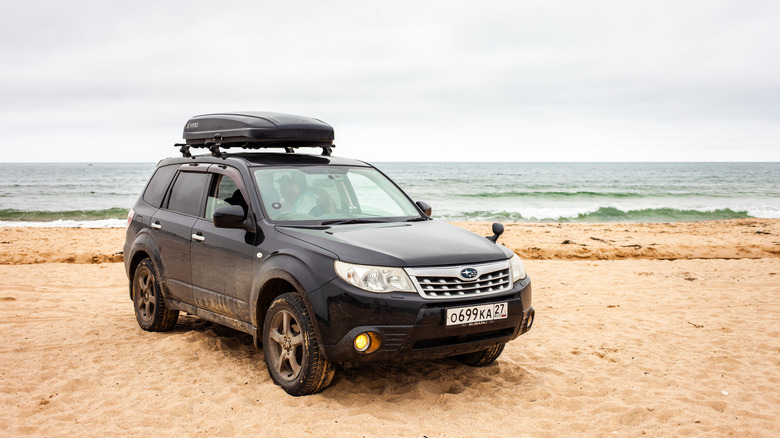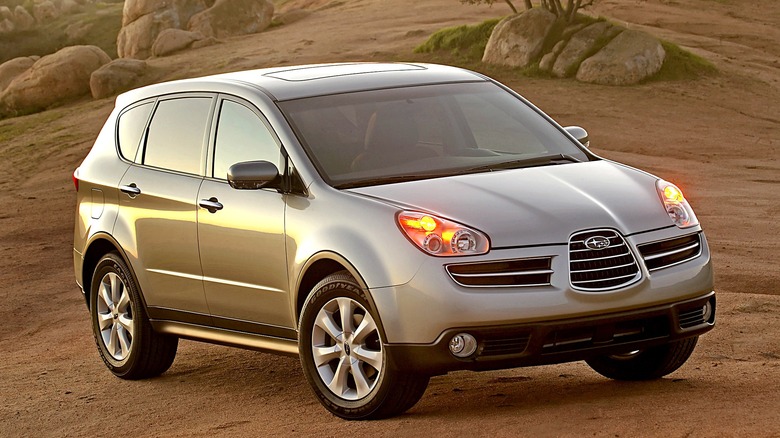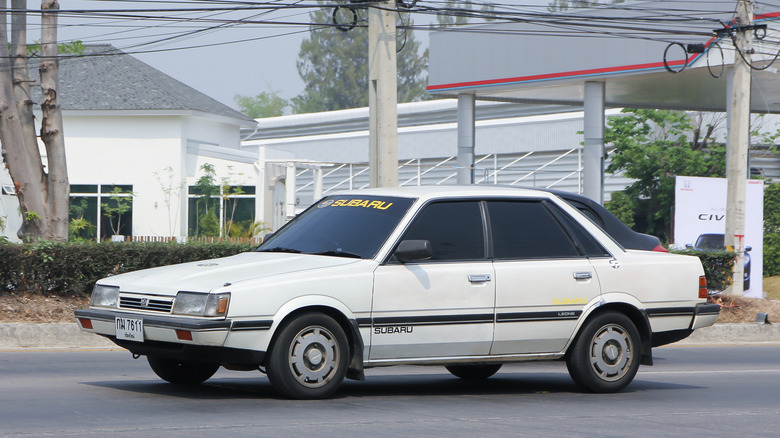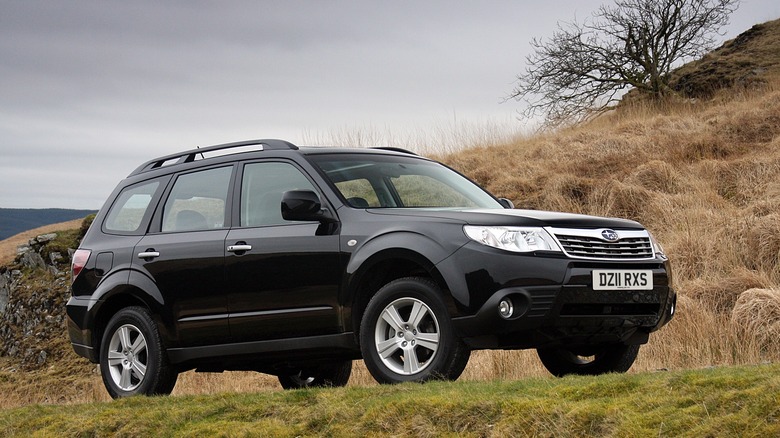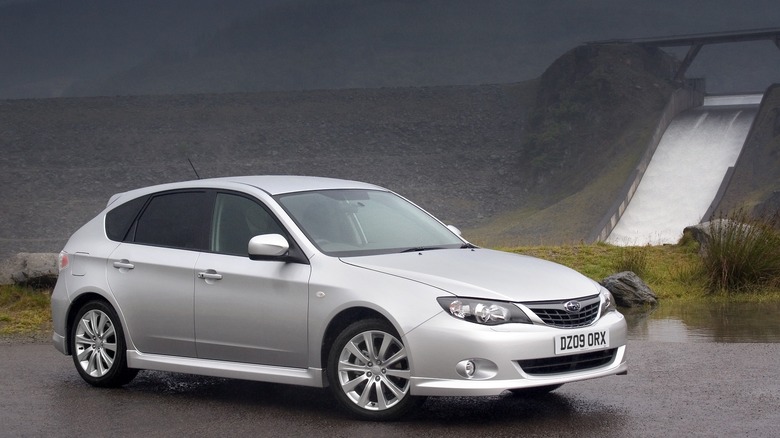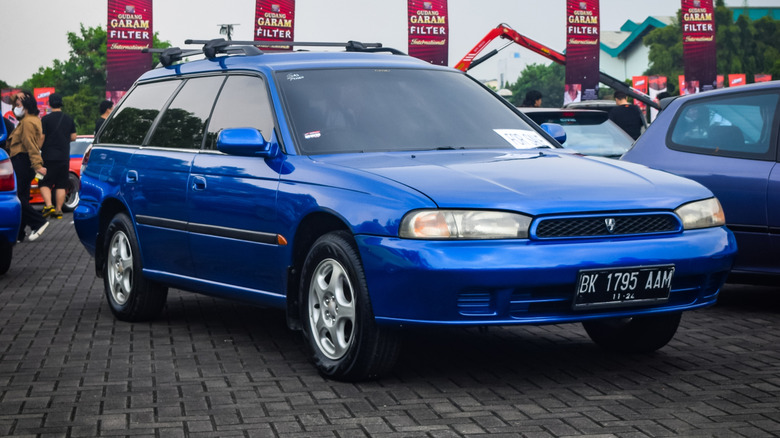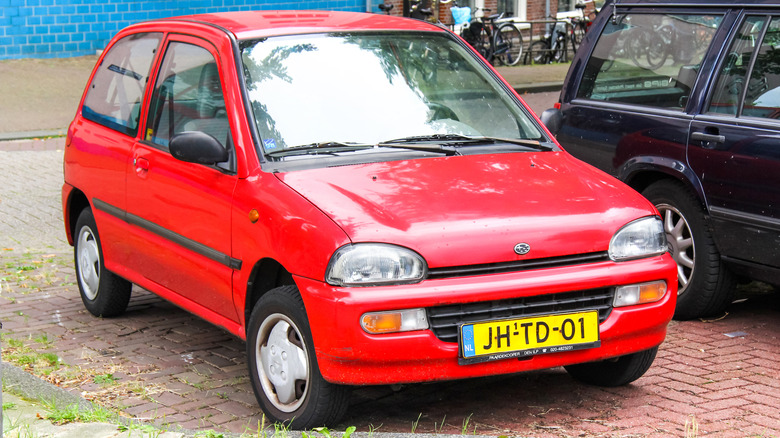7 Of The Most Boring Subaru Models Ever Designed
In the 1960s, Fuji Heavy Industries started releasing cars under the name Subaru. However, while its first car, the 360, was like a Volkswagen Beetle that had been left in the dryer for a little too long, the company would become known for practical cars, with a serious focus on AWD on even the most normal of vehicles, and of course, an engine with horizontally opposed cylinders, better known to us as the boxer.
Over the past 60 years, Subaru has carved out a niche for itself, building some very exciting and very attractive looking cars. From the handsome fourth generation Legacy to the charismatic lifted wagon appearance of the first and second generation Forester, Subaru's design team has knocked out some well-known and well-loved designs. However, as is the case with every automaker, there have been some stinkers in there as well. These cars are not just unsightly to look at, but also uninspired and boring.
Subaru B9 Tribeca
Subaru definitely took a gamble on this one. Introduced in the mid 2000s, the B9 Tribeca, as it was originally known, was intended as Subaru's flagship SUV. It was a more upmarket offering, intended to compete with the likes of the Acura MDX. Straight away, the B9 Tribeca had a lot of issues.
The name sticks out, for one thing. Back in those days, Subaru had the idea to give each of its models an alphanumeric name to signify where they slot in the lineup, followed by the actual name of the model. Perhaps unsurprisingly, the B9 Tribeca was the first and only example of this.
The original Tribeca was also... stylistically challenged. While the bewinged front grille design worked very well on the Hawkeye Impreza, putting it on a massive SUV like the Tribeca was just not the right thing to do. Even with that in-your-face front end design, the Tribeca was just completely unremarkable.
Subaru scrambled to facelift the Tribeca for the 2008 model year, giving it a normal front end design and dropping the B9 moniker, but it was too late. One good thing about the Tribeca was its only powertrain option: a naturally aspirated flat six. You know, like a Porsche! Perhaps unsurprisingly, the Tribeca was a complete flop.
Subaru Leone
One other strong suit of Subaru as a brand that is definitely worth pointing out is station wagons. Subaru wagons have been around for decades, and the current Outback is still a fantastic performer. What has to be ground zero of the wagon with a blue galaxy badge on the front is the Leone.
The Subaru Leone was only sold in three generations before being replaced in the lineup by the Impreza. The first generation Leone was an attractive thing, with a little air of the original Toyota Celica and Nissan Silvia about it. Sadly, with the second and third generation Leone, the styling shifted to... a generic 1980s economy car. The Leone is a classic Subaru today, but there's nothing particularly interesting about the way it looks.
Like a true Subaru, the Leone kept all the core pillars of the brand intact. Power came exclusively from boxer powertrains, and a 4WD lifted wagon version was available. The Leone also deserves a little more credit than we're giving it here, because it formed the basis for two far more interesting Subaru vehicles: the wonderfully 80s XT sports car, and the super practical and lovable BRAT pickup truck. One way to make a Leone wagon more exciting is to give it a 900 hp engine and active aerodynamics, as Travis Pastrana did.
Subaru Forester (SH)
The original Forester was Subaru's first ever SUV, and it came along around the time when SUVs were starting to shift toward a road focus, rather than being tools used to reach places that other cars couldn't. The Forester took this whole approach a step further by not really resembling a proper SUV, being a lot closer to a station wagon with raised ride height.
The same was true of the second-generation Forester, it still had raised ground clearance and it had AWD, but it resembled a boxy lifted wagon more than a traditional SUV. Sadly, this philosophy didn't last very long, as the third generation SH Forester, introduced in 2009, morphed into a fairly traditional looking SUV.
Now sure, traditional SUV doesn't always mean something bad, but in the case of the Forester, it just lost that magic that originally made it unique. It transitioned to a boring look that was very similar to its competitors, and it wasn't helped by the equally boring interior. There were some good powertrains on offer, but the original concept of the Forester was lost with the third generation car, making it a little more conventional and a little less interesting as a result.
Subaru Impreza (GH)
The Leone went out of production in the early '90s, after which it was succeeded by the Subaru compact a lot more people are familiar with: the Impreza. The original Impreza, along with the second generation, took a different approach to the established compact car ingredients.
It was still very much a compact car, but it was a sedan from the get-go, with a proper trunk. While it wasn't groundbreaking, it was certainly a distinctive car. The Blob Eye and Hawk Eye iterations of the Impreza were both part of the second generation, and they were both definitely distinctive. The third generation Impreza, which was quickly given the Stink Eye nickname, came along in the late 2000s.
Like the Forester, whose third generation also came out in the late 2000s, the Impreza suffered the same fate — it became a little more subdued. Subaru tried its best to spruce up the high performance versions with quad exhausts and big wings, but in its basic form, the Impreza simply didn't do enough to distinguish itself from the competitors. If you saw a basic third-gen Impreza hatch or sedan parked on the street, you wouldn't take a second glance at it.
Subaru Legacy (second generation)
One of Subaru's most well-known models aside from the Impreza is definitely the Legacy. The swanky mid-size sedan first appeared in the '90s, and sadly it's about to go out of production, as the mid-size sedan market continues to shrink.
The Legacy has almost always been a looker, especially the handsome fourth generation car with its sorted proportions and overall authority. However, the second generation Legacy doesn't bring anything particularly exciting to the table.
Sure, the styling was very correct for the '90s, including that fantastic reflective rear light bar. However other than that, the second generation Legacy blends in a little too well with its surroundings, and to the untrained eye, it could be mistaken for a lot of '90s Japanese cars. This is when Subaru really wasn't doing anything particularly exciting with design, but at least the second-generation cars had plenty to offer if you look past their uninspired designs.
Subaru Vivio
Along with length and width, engines, and power outputs, kei cars also have one more thing in common, aside from a lot of them being quite affordable: they all have a lot of character. Whether it would be because of their obscenely tall profiles, or the flashes of extra personality in individual styling details, it's tough to forget a kei car even after a passing glance.
The same cannot be said of one of Subaru's kei hatchbacks, the Vivio. Although it was sold as a kei car in Japan, this is one of a handful of kei cars that was sold in a handful of export markets with a larger engine. In terms of styling... there's no getting around it, the Vivio is just a bit dull.
Those aforementioned dashes of character that we see in other kei cars are nowhere to be seen here. Sure, it's cute due to its diminutive dimensions, but other than that, there's really not much to speak of. The Vivio can just be described as a "tiny car," and in a world where a lot of the competition has at least one major styling quirk that makes them stand out, that's not really the best look.
Subaru Dex
Badge engineering is the process by which various automakers can launch the same car under a variety of brands and models. It saves development costs and gives both automakers a new source of profit. It's something that Subaru has taken part in as well.
Of course, there was the Saab 9-2X, which was a Subaru WRX Wagon in Scandinavian getup, but the Dex is a different story. Underneath the boxy bodywork, and if you pay close attention to the details, the Dex is just a lightly reskinned version of the Toyota bB.
The preceding generations of the Toyota bB also formed the basis for the Scion xB — until Toyota decided to dissolve Scion — and the second-generation cars were sold in other export markets as the Daihatsu Materia. One obvious downside to this particular badge engineering job is that the Subaru Dex didn't have a boxer engine. But also, looking past the quirky boxiness of the whole thing, the Dex isn't anything special to look at. It's a boxy JDM-only car, which gives it some brownie points, but it's a pretty forgettable economy car otherwise.
